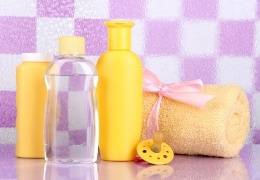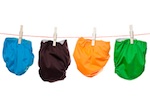There are many accessories that go with nappies. Check out this handy guide to nappy accessories to see what will be useful.
Whether you are using disposables or cloth nappies, nappy time is not just about nappies. There are all sorts of things that make life easier in this area and some you really can’t live without. Use this handy checklist to find out what nappy accessories you will need in order to survive nappy time in your home.
Absolute Essentials in Nappy Accessories
Baby Wipes
If you are changing nappies, then there is going to be mess to wipe up. Disposable wipes are readily available in supermarkets and there are plenty to choose from. Every parent has a favourite brand, so try a few types of baby wipes, until you find one you really like. Most are available in plastic containers as well as travel and refill packs.
If you prefer a more natural approach to wipes, then you will need some soft cloths for cleaning baby’s bottom. Choose a single colour so you know they are ‘bottom cloths’ only, or stitch on a tag to distinguish them from all the others.
Wet Nappy Bag
Whether you are using disposable nappies or modern cloth nappies, you are going to have to do something with your wet nappies when you’re out and about. It is not always possible or appropriate get rid of your disposables, and you certainly can’t leave your fabric nappies behind, so you’ll need a wet nappy bag of some sort.
Plastic shopping bags are a good cheap option, or you can purchase scented plastic bags from the supermarket which are designed specifically to mask nappy odours. If you are looking for a more eco-friendly approach, you could use a child’s tog bag or a washable nappy tote which can be purchased from a number of eco-stores online.
Nappy Liners, Pins and Overnaps
If you are using traditional cloth nappies, you will need all the bits and pieces which make the system work. You can buy disposable liners from the supermarket, but if you are using reusable nappies, it’s no more hassle to use reusable liners as well. Not only will they save you stacks of money in the long run, they are also a lot softer on baby’s skin.
Overnaps are worn over the nappies to stop any wetness soaking through to baby’s clothes. There are lots of styles and colours available and they are readily available at both baby and department stores.
Change Mat
Every parent needs somewhere to lay their baby whilst changing their nappies. The cheapest option to take is the towel or nappy on the floor approach. The floor is a great place to change nappies, because baby cannot fall off the floor!
Alternatively, you could purchase a change mat which provides you with a clean, convenient place to change your baby no matter where you are. Most baby bags come with an appropriate change mat, but if yours doesn’t they can be purchased separately. Look for one that is slightly padded for comfort and make sure the material is wipeable so you can keep it clean without too much fuss.
Baby Bag
Despite babies being small, they seem to need an inordinate amount of “stuff” to keep them well serviced! For this reason, every parent needs a baby bag of some sort when going out and about. See our article on Baby Bags for more detail on this subject.
Nappy Bucket
If you are using traditional cloth nappies you will need 1 or 2 nappy buckets to soak your nappies in before washing. Make sure the bucket has a lid which can be properly secured and a handle which can cope with the weight of a full load. Modern cloth nappies usually do not need pre-soaking, but you will still need a separate bucket, bin or hamper to collect them in before washing.
Washing Powder and Soak Solutions
If you are washing nappies, you will obviously need something to wash them with. There are plenty of well-known soak solutions on the market, or you can take the natural approach and simply soak your nappies in water with a few drops of Tea Tree essential oil.
When it comes to the washing part, make sure you use a washing powder that is biodegradable. Powders that are not biodegradable build up on the nappy, inhibiting absorption and promoting build up on the baby’s skin.
For more information about washing powder options, check out our Going Natural with Nappies article.
Nappy Accessories – Nice to Haves
Change Table
For a bit of luxury (and for saving your back) change tables take some beating. You don’t have to spend a fortune, but keep in mind safety and hygiene issues when making your choice. Our Bathing and Changing section provides a good checklist of things to consider when buying a change table.
Storage Containers for Nappies
Nappies are one of those things you always need to have plenty of, so you need to have a place or system for storing them. Some parents simply stack them under the change table or on a near by shelf, while others use some sort of container to keep them all in one place. For a short time I had 2 children in cloth nappies, so the washing pile became ‘the place’ by default.
If you prefer a more organised approach, then there are plenty of great containers you can use. Cane baskets, plastic cubes, decorated boxes or fabric hangers are all great options, but you can adapt just about any container to suit your needs.
Barrier Creams
The best way to prevent nappy rash is to change your baby regularly and allow them plenty of time to bare their bottom in the fresh air. It doesn’t hurt, however, to have some barrier cream on hand just in case.
Barrier creams are available in supermarkets and pharmacies, as well as some baby shops and department stores. Health shops are likely to carry natural nappy rash creams and may suggest other natural remedies also. If you are confused by the huge selection, or just not sure which cream is right for your baby, ask your midwife or Plunket nurse for advice.
Clothes Rack
Like it or not there will be days or weeks when it does not stop raining and if you are using cloth nappies they will start building up around your ears. A clothes rack is a good way to stay on top of the nappy washing, without having to revert to using the dryer. You can purchase clothes racks from department stores for about $15. Alternatively, you could string a line up in your garage or carport to give more hanging space.
Nappy Bin
If you are using disposables, then a small bin near the change table is really useful. You could use an ordinary bin lined with scented plastic bags to mask the odour, or invest in a disposable nappy unit which wraps and seals the nappy before dropping it into the bin. Nappy units are available from most specialist baby stores, as well as online, and cost between $60 and $100. Alternatively, you could simply wrap dirty nappies in a plastic shopping bag and place the parcel in your normal rubbish bin.
Nappy Sprayer
A nappy sprayer is by no means essential, but they are definitely a fabulous invention. The sprayer is simply a shower head on a long hose, which attaches to the pipe behind your toilet. When you have nappies which are heavily soiled, you can wash the nappy contents off the nappy without having to get up close and personal. The sprayer is also great for cleaning up toilet training accidents on both the floor and the child. Nappy sprayers are available online and cost approximately $80.
Useful Articles:
Check out the following articles before you go shopping:
Nappies– whether to choose cloth flats, disposables or modern cloth nappies.
Baby Bags – find out which one is right for you
Bathing & Changing – an overview of all the gear you might need for your new baby





